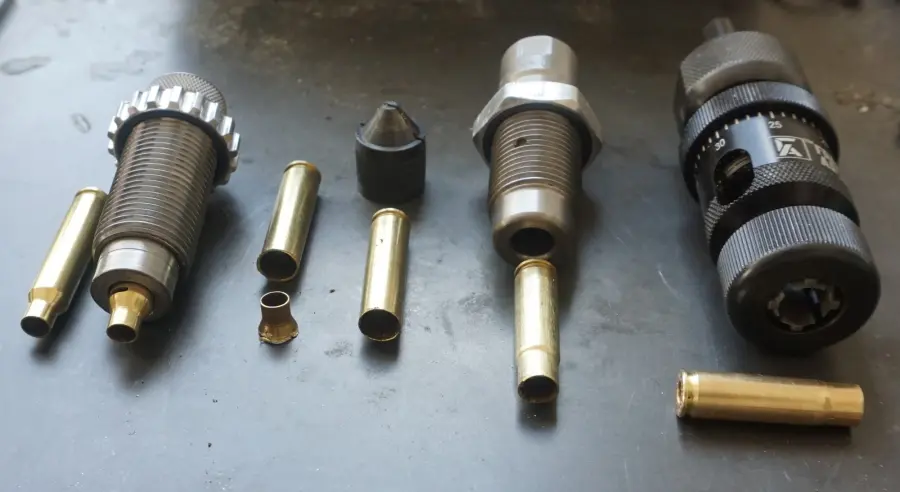.300 BLK from .223 Rem

Given the high cost of factory .300 BLK ammo and new brass cases, and the unavailability of fired ones, many reloaders may consider reworking commonly available .223 Rem brass instead. How does this process work, and is it worth it?
The AR-15 platform benefits from easily accessible user modifications, including relatively simple caliber conversions, not to mention the availability of many models beyond the standard .223 Rem. After 9x19 mm Luger, .300 BLK (AAC Blackout) is the most commonly used alternative, mainly among shooters seeking a suppressed specialty round. Factory-loaded ammo available on our market is significantly more expensive than .223 Rem, so reloading makes a lot of sense — which raises the question of where to get brass. You can collect your own by shooting, but that will cost you at least 18.6 CZK per shot (SB FMJ 147 gr – beareka.cz), or you can buy new brass for 13 CZK/piece (Starline – strobl.cz). Because of this, fired .300 BLK cases are rare on shooting ranges and sell out quickly when they appear online. However, there is an alternative approach: you can safely and reliably make your own .300 BLK brass from .223 Rem. Here's how.
Making Your Own Blackout
The process is, in theory, quite simple. From a .223 Rem case, you cut off the neck, deburr the edges, run it through a full-length sizing die, trim it to the correct length, deburr the edges again, and you have a .300 BLK case.
Specifically, you trim the case to 34.5 mm. Ideal tools include specialized devices such as the “Mini Miter Cut-Off Chop Saw” by JounJip. Regular case trimmers aren't efficient for this task, but a standard angle grinder mounted in a jig for precise cuts works well. Personally, I only reload .300 BLK occasionally and have a reserve of 300 cases, so I used a discarded die as a jig, inserted the cases, roughly trimmed them by hand with a grinder, and then precisely cut them to 34.5 mm with a trimmer. Next is deburring the outer and inner case mouth to remove burrs, just like with regular brass prep. Then comes resizing. I found it helpful to remove the decapping pin from the die for the first pass, followed by a second pass with the pin installed. The cases must be thoroughly and generously lubricated — even then, the die takes quite a beating. For casual shooting, this doesn’t matter, but if you’re aiming for high precision and invested in expensive precision dies, it’s worth buying an extra, inexpensive full-length sizing die dedicated to case forming. The final step is trimming the case to a standard length in the range of 34.24–34.75 mm and once more deburring the mouth.
 Brass cases in individual stages of conversion from .223 Rem (left) to .300 BLK (right).
Brass cases in individual stages of conversion from .223 Rem (left) to .300 BLK (right). You can cut the neck off even with a regular angle grinder and a bit of improvisation when making the jig.
You can cut the neck off even with a regular angle grinder and a bit of improvisation when making the jig. You'll need a proper case trimmer. From my own experience, I can recommend the universal drill-mounted case trimmer from Frankford Arsenal (strobl.cz)
You'll need a proper case trimmer. From my own experience, I can recommend the universal drill-mounted case trimmer from Frankford Arsenal (strobl.cz) Demonstration of modification stages including the tools used.
Demonstration of modification stages including the tools used.Is It Better to Buy New?
In practice, it’s not such a simple process. First of all, not every case is suitable. Hornady and sometimes GGG cases work, but reformatting Lapua, SB, or Aguila cases is significantly more difficult. During resizing, they offer unacceptable resistance, resulting in deformed necks and deviations that won’t pass a case gauge — and repeated sizing doesn’t fix the problem. In the worst-case scenario, the case rim can tear off during extraction from the die, requiring punching it out. The best prevention is very thorough preparation: deep chamfering of the rim, shortening the neck about half a millimeter below the recommended value, and slightly polishing down the decapping pin mounted in a drill to reduce its diameter by a few tenths of a millimeter. This gives the neck a bit more clearance and less friction during sizing. Even so, the defect rate can be up to one-third of the cases, and combined with the labor-intensive process, the economics don’t work out. Even in the best-case scenario, producing one case takes a minute with Hornady brass — with SB it takes twice as long.
If you have Hornady brass readily or freely available, a well-equipped reloading bench, and the willingness to take it on, then go for it. Otherwise, I’d recommend spending a bit more on new brass from Starline, which is a proven choice with a long lifespan — or, if you're lucky, once-fired range brass, if you can find any.
Photo sources: Author's archive
Author: Tomáš Prachař
The article originally appeared in Lovec magazine by Extra Publishing











